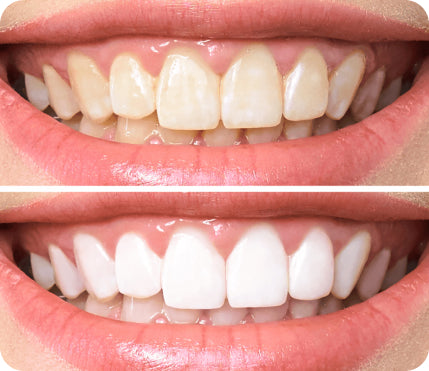
All products are certified by dental expert Dr. Greg Grillo
Get ready to dive into the fascinating world of tooth gemination - an intriguing and rare dental anomaly that often leaves people puzzled and concerned.
In this captivating 2023 guide, we'll take you on a journey through the ins and outs of tooth gemination, unraveling its mysterious causes, demystifying the diagnostic process, exploring innovative treatments, and unveiling crucial information to put your mind at ease.
What Is Tooth Gemination?
Tooth gemination occurs when a developing tooth tries to split or divide itself, resulting in the formation of two partially separate tooth crowns fused together. This creates a single enlarged tooth that appears to be two conjoined teeth. Although tooth gemination primarily affects baby teeth, it can also be found in permanent teeth.
Causes Of Tooth Gemination
The exact cause of tooth gemination remains unclear, but various factors have been proposed to contribute to its occurrence. These factors may include genetic developmental anomalies, prenatal exposure to certain medications or toxins, and trauma or infections during tooth development.
How To Identify Tooth Gemination
A tooth with gemination typically presents as an oversized tooth that takes up extra space in the dental arch. It might display a notch on the biting or incisal surface, signifying the incomplete division of the tooth into two separate crowns. Dentists use X-rays to confirm a diagnosis of tooth gemination, as these images can provide a clear picture of the tooth's internal structure and how it's rooted in the jaw.
Treatment Options For Tooth Gemination
Treatment for tooth gemination depends on factors such as the extent of the issue, the patient's age, and the overall impact of the condition on the individual's oral health. In mild cases, regular dental monitoring and proper oral hygiene should be sufficient. For more severe cases or when complications arise, various treatments may be considered, such as:
- Dental restoration to improve the tooth's shape and function
- Orthodontic treatment to address any spacing or alignment issues
- Endodontic therapy (root canal) if the tooth's nerve is affected
- In extreme cases, extraction and replacement of the tooth might be recommended.
Maintaining Dental Health With Tooth Gemination
Keeping a close eye on oral hygiene is essential for those with tooth gemination. Since these enlarged teeth can be more challenging to clean, extra care should be taken to ensure thorough brushing and flossing daily.
Remember to consult with your dentist regularly to monitor the tooth's development and receive ongoing guidance on managing tooth gemination. This comprehensive guide for 2023 aims to equip you with the knowledge and confidence to better understand tooth gemination and make informed decisions about your dental health.
Tooth Gemination Signs And Symptoms
Tooth gemination is a dental anomaly where a single tooth develops as if it was two teeth fused together. Some of the visible and sensory indications of tooth gemination include the following:
- A single tooth in your mouth having a clear separation or division, making it appear nearly as two teeth
- The presence of an unusually wide or large tooth that deviates from the norm and affects your bite or alignment
- Experiencing discomfort or sensitivity in that particular tooth due to its irregular shape or size
- Encountering an increased risk of decay, gum disease, or other dental complications related to the misaligned or abnormally structured tooth
Recognizing the signs and symptoms of tooth gemination can help you determine if you are dealing with this dental issue.
Causes Of Tooth Gemination
The exact cause of tooth gemination remains unknown, as various factors can contribute to its development during the tooth formation process. Here's a look at some possible influences on tooth gemination:
- Genetic factors: Research has shown that tooth gemination may have a genetic component, as it tends to cluster within families.
- Trauma: Any physical injury to the mouth or jaw might interfere with the tooth's developmental process, leading to gemination.
- Dental lamina abnormality: Tooth gemination may be related to issues affecting the dental lamina, the structure responsible for initiating tooth development.
While tooth gemination is relatively rare, it is essential to be aware of its signs and potential causes to ensure that you can seek appropriate dental care when needed. Regular dental checkups can help identify tooth gemination early, allowing for proper treatment and management of this dental anomaly.
Diagnosing Tooth Gemination: A Thorough Evaluation
In order to properly diagnose tooth gemination, a dental professional will conduct a comprehensive oral examination. This examination will involve not only a visual assessment of the patient's teeth and gums but also an evaluation of the patient's medical and dental history to better understand any pre-existing oral health issues or related factors. This information-gathering process can help the dentist determine if tooth gemination is indeed the cause of the dental anomaly.
In some cases, the dental professional may also recommend taking X-rays to get a more in-depth look at the affected tooth or teeth. These images can be crucial in determining the extent of the anomaly, as well as identifying the presence of separate pulp chambers within the geminated tooth. Additionally, X-rays can help the dentist uncover any underlying dental issues that might be connected to the gemination.
Tooth Gemination Treatment Options: Tailored To Your Needs
When it comes to treating tooth gemination, the appropriate course of action depends on several factors, such as the severity of the condition, the patient's age, and the presence of any associated dental issues. Based on a thorough assessment, dental professionals will recommend the most suitable treatment options for the individual case. These options may include:
- Monitoring without intervention: In some cases, a geminated tooth may not cause significant problems. If this is the case, the dentist may decide to monitor the situation closely without taking any immediate action.
- Filing or reshaping the tooth: If the geminated tooth has an irregular shape or is causing bite issues, the dentist might choose to file or reshape the tooth. This process can improve the appearance of the geminated tooth and alleviate any issues with the patient's bite.
- Application of dental sealants: In order to protect the geminated tooth from decay, dental professionals may recommend the use of dental sealants. This involves applying a protective coating to the tooth's surface, creating a barrier against bacteria and plaque.
- Root canal treatment or extraction: In cases where the geminated tooth has experienced significant decay, infection, or other complications, more invasive treatments may be required. These options could include root canal therapy, which involves removing the infected pulp from the tooth, or extraction, where the dentist removes the entire tooth.
By selecting a treatment plan tailored to the specific needs of the patient, dental professionals can ensure that the best possible outcomes are attained for those experiencing tooth gemination.
What To Do About Geminated Teeth: Identifying And Addressing The Issue
If you suspect that you or your child may be dealing with a gemination tooth, it's crucial to consult a dental professional for a thorough evaluation and proper diagnosis. Early identification and treatment of gemination can help prevent potential complications and ensure good oral health in the long run.
Adequate precautionary measures should be undertaken - this includes maintaining regular dental visits, practicing proper oral hygiene for optimal dental health, and seeking professional advice if any concerns or questions arise regarding gemination.
Understanding The Differences Between Tooth Fusion And Gemination
Tooth fusion and gemination are both dental anomalies that involve the appearance of two conjoined teeth. It is vital to understand their differences as they might be mistaken for each other. Let’s take a closer look at the key distinctions between these conditions.
- Tooth fusion: Tooth fusion takes place when two adjacent teeth combine in a unique way - their dentin layers connect, forming a single enlarged tooth structure. Although fused teeth appear conjoined, they typically have separate crowns and individual roots. This distinct anatomical feature can be clearly identified through dental X-rays.
- Tooth gemination: Unlike tooth fusion, gemination results from a single tooth germ that attempts to split or divide during its development process. As a consequence, a partially or wholly divided tooth may arise, giving the appearance of an extra tooth. However, geminated teeth generally possess a single root, and often, they might also share a common pulp chamber.
By comprehending the differences between tooth fusion and gemination, dental professionals can properly diagnose and treat any dental issues arising from these anomalies to ensure optimal oral health.
Example Of Tooth Gemination
A textbook example of tooth gemination can be seen when a patient presents with an unusually wide, single incisor, typically located at the front of the upper or lower jaw. Upon closer investigation, a distinct and noticeable ridge can be observed running along the tooth's midline, which signifies that the tooth's division process during development was incomplete. These teeth can exhibit minimal signs of functional disturbance, such as biting or chewing discomfort, or display other atypical features.
Visual Indicators Of Tooth Gemination
Tooth gemination, from a visual standpoint, manifests as an enlarged, uniquely-shaped tooth that appears to have a distinct separation line or ridge, giving the impression of two conjoined teeth. The affected tooth may present with irregular contours, making it challenging to maintain regular cleaning and dental hygiene practices due to the tooth's abnormal shape. Additionally, the gum tissue surrounding the impacted tooth may appear inflamed, irritated, or swollen, further emphasizing the unusual nature of tooth gemination.
Is Gemination Genetic? A Closer Look At The Connection
While the exact cause of tooth gemination remains a mystery, some evidence suggests that a genetic component may be involved. Tooth gemination has been observed to cluster within families, hinting at a possible relationship with hereditary factors. Nonetheless, more extensive research is needed to confirm the role of genetics in the occurrence of tooth gemination and to better understand how different genes may influence its development.
Understanding The Two Types Of Gemination
Tooth gemination can be classified into two main types – gemination and twinning – based on the structure and development of the involved tooth:
- Gemination occurs when the division process originates from a single tooth bud before calcification. This results in a tooth structure that appears to be two teeth joined together but actually shares one root and a common pulp chamber. As a result, true gemination produces a larger-than-normal tooth with a bifurcated crown, or something that looks like two incomplete formations.
- Twinning arises when the single tooth divides completely into one regular tooth and one supernumerary tooth.
Both forms of gemination can cause discomfort and potential complication.
Tooth Gemination In Babies: What Parents Should Know
Tooth gemination primarily affects deciduous (baby) teeth, with the incisors being the most commonly impacted. Although this dental anomaly often resolves by itself as permanent teeth erupt, it remains crucial for parents to monitor the development of the geminated tooth and maintain excellent oral hygiene for their child.
If you suspect your child may have geminated teeth, it's essential to consult a pediatric dentist. Early intervention can prevent complications, such as improper tooth alignment or difficulty in maintaining good oral hygiene, and promote proper tooth development.
Summary: Tooth Gemination And Its Implications For Oral Health
Tooth gemination is a dental anomaly characterized by an enlarged tooth structure that appears to be two teeth joined together. Although the precise cause of this condition is still not fully understood, potential genetic factors have been implicated.
Gemination is primarily classified into two types – gemination and twinning – based on the tooth's structure and developmental process. Gemination is more commonly found in baby teeth, particularly the incisors.
Early diagnosis and proper management of tooth gemination are vital to prevent complications and promote optimal oral health. Dental professionals can diagnose and treat gemination through thorough oral examinations, X-rays, and customized treatment approaches. To protect against potential issues, make sure to maintain regular dental visits and practice good oral hygiene habits.












